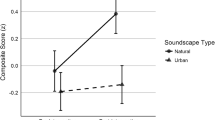Abstract
It was found that ergotropic arousal inducing drugs, such as psilocybin, a Ditran®-type ‘glycolate’ andd-amphet-amine, significantly lower human spatial distortion thresholds, i.e. these drugs, interfere with counter-adaptation to optical distortion, or the expectation to see the world undistorted. The trophotropic arousal inducing chlorpromazine® on the other hand promotes such counter-adaptation, i.e. the optimization of visual information. Optimization is independent from the rat at which the distorting stimulus is presented.
Optimization is regarded here as a cortical (perceptual-behavioral) interpretive process while interference with and promotion of the optimization are subcortical influences.
Similar content being viewed by others
References
W. Hess, in:Pharmacology, 2nd ed. (Ed. H. Beckman; W. Saunders, Inc., Philadelphia 1969), p. 292.
E. Gellhorn,The Emotions and the Ergotropic and Trophotropic Systems, Psychol. Forsch.24, 48–94 (1970).
E. V. Efstathlou,Effects of Exposure Time and Magnitude of Prism Transform, on Eye-Hand Coordination, J. exp. Psychol.81, 235–240 (1969).
H. Isbell, A. Wolbach, A. Wikler andE. Miner,Cross-Tolerance between LSD and Psilocybin, Psychopharmacologia2, 147–159 (1961).
A. Wolbach, H. Isbell andE. Miner,Cross-Tolerance between Mescaline and LSD-25, Psychopharmacologia3, 1–14 (1962).
F. Hebbard andR. Fischer,Effects of Psilocybin, LSD and Mescaline on Small, Involuntary Eye-Movements, Psychopharmacologia9, 146–156 (1966).
R. M. Hill, R. Fischer andD. Warshay,Effects of Excitatory and Transquilizing Drugs on Visual Perception: Spatial Distortion Thresholds, Experientia25, 171–172 (1969).
R. H. Rengstorff, U.S. Army ResearchLaboratories, Edgewood Arsenal, Maryland, unpublished report 1969 (private communication).
R. Fischer, P. Marks, R. Hill andM. Rockey,Personality Structure as the Main Determinant of Drug-Induced (Model) Psychoses, Nature218, 296 (1968).
R. Fischer, T. Kappeler, P. Wisecup andK. Thatcher,Personality Trait Dependent Performance under Psilocybin, Dis. nerv. Syst.31, 91–101 and 181–192 (1970).
P. H. Gwynne, R. Fischer andR. M. Hill,Hypnotic Induction of the Interference of Psilocybin with Optically Induced Spatial Distortion, Pharmakopsychiat. Neuro-Psychopharmak.2, 223–234 (1969).
R. Fischer,Psychotomimetic Drug-Induced Changes in Space and Time, Proc. 4th Int. Congr. Pharmacology3, 28–77 (Benno Schwabe, Basel 1970).
Y. Akishige,Perceptual Constancy and the Law of Conservation of Perceptual Information, Bull. Fac. Lit. Kyushu University9, 1–48 (1965).
W. Wittreich andK. Radcliffe,The Influence of Simulated Mutilation upon the Perception of the Human Figure, J. abnorm. Psychol.51, 493–495 (1955).
W. Wittreich,The Honi Phenomenon: A Case of Selective Perceptual Distortion, in:Explorations in Transactional Psychology (Ed. F. Kilpatrick; New York University, New York 1961), p.188–221.
R. Fischer,Out on a (Phantom) Limb. Variations on the Theme: Stability of Body Image and the Golden Section, Perspect. Biol. Med.12, 259–273 (1969).
M. Simmel,Phantom Experiences Following Amputation in Childhood, J. Neurol. Neurosurg. Psychiat.25, 69–78 (1962).
R. Fischer,The Perception-Hallucination Continuum (a re-examination), Dis. nerv. Syst.30, 161–171 (1969).
R. Fischer,Prediction and Measurement of Hallucinogenic Drug-Induced Perceptual-Behavioral Change, in:Origin and Mechanisms Hallucinations (Ed. W. Keup, Plenum, New York 1970).
G. H. Fischer,Geometrical Illusions and Figural After-Effects; the Mechanism, and Its Location, Vision Res.11, 289–309 (1971).
R. Fischer andD. Warshay,Psilocybin-Induced Autonomic, Perceptual and Behavioral Change, Pharmakopsychiat. Neuro-Psychopharmak.1, 291–302 (1968).
R. Fischer A Biochemistry of Behavior? Biol. Psychiat.1, 107–109 (1969).
K. Thatcher, T. Kappeler, P. Wisecup andR. Fischer,Personality Trait-Dependent Performance under Psilocybin, Dis. nerv. Syst.31, 181–192 (1970).
R. Fischer,Arousal-Statebound Recall of Experience, Dis. nerv. Syst., in press (1971).
Author information
Authors and Affiliations
Rights and permissions
About this article
Cite this article
Hill, R.M., Fischer, R. Interpretation of visual space under drug-induced ergotropic and trophotropic arousal. Agents and Actions 2, 122–130 (1971). https://doi.org/10.1007/BF01966750
Received:
Issue Date:
DOI: https://doi.org/10.1007/BF01966750




